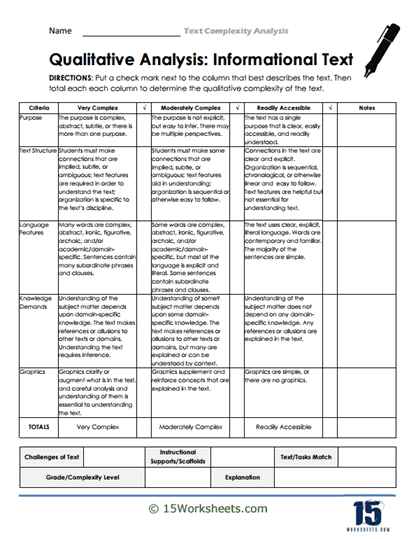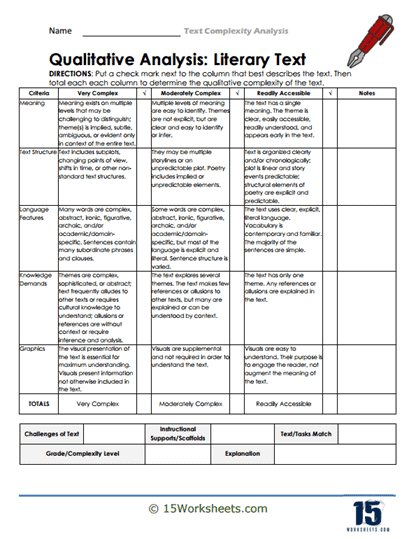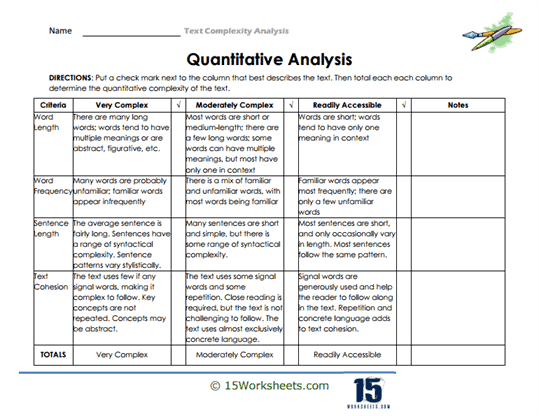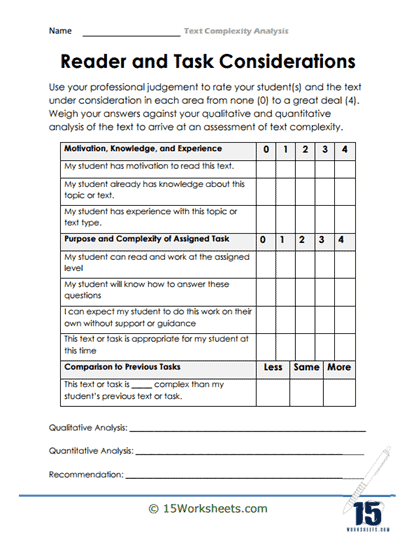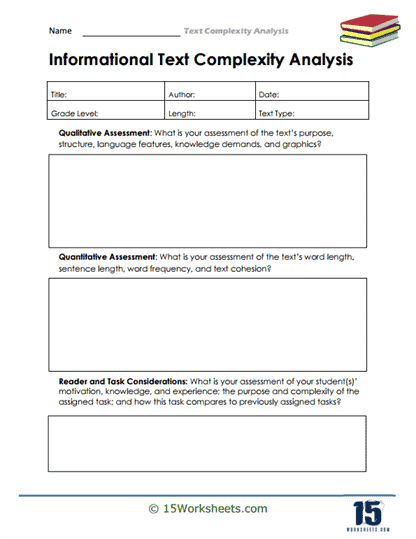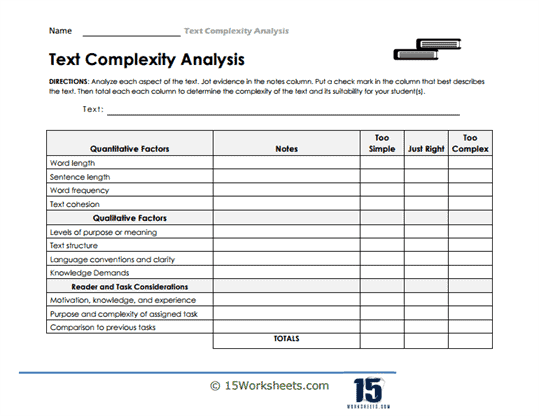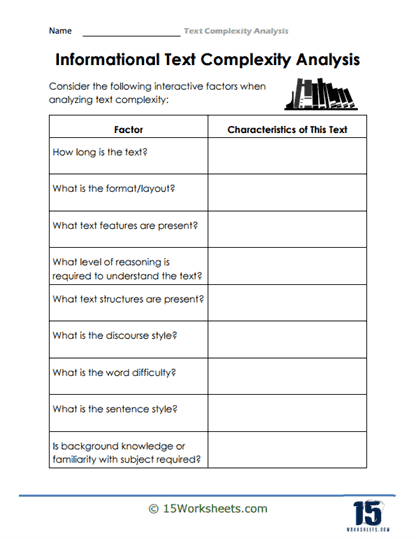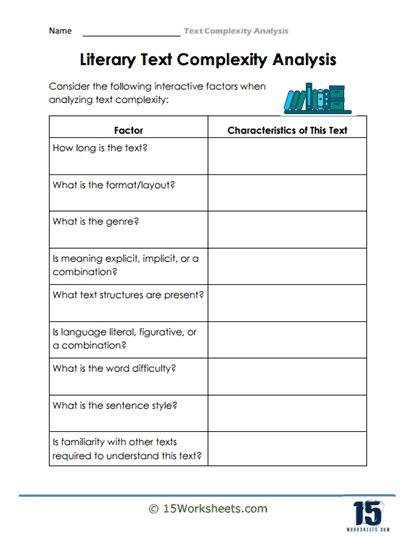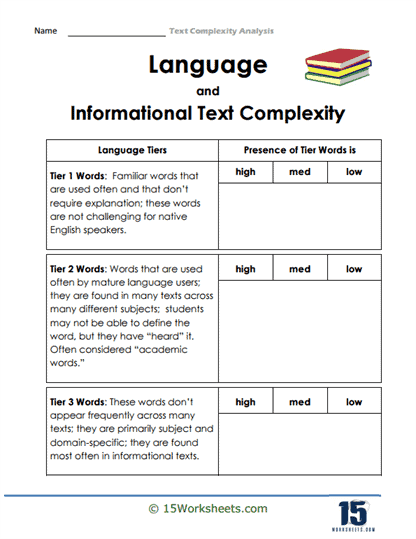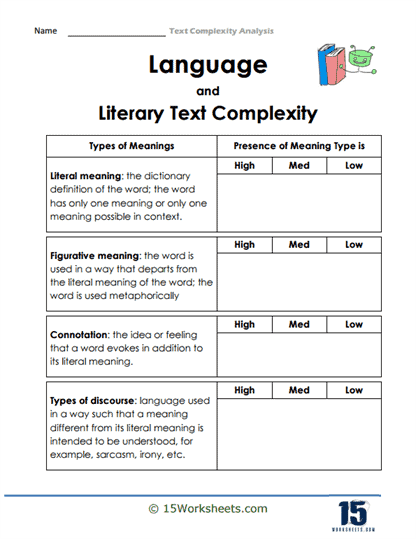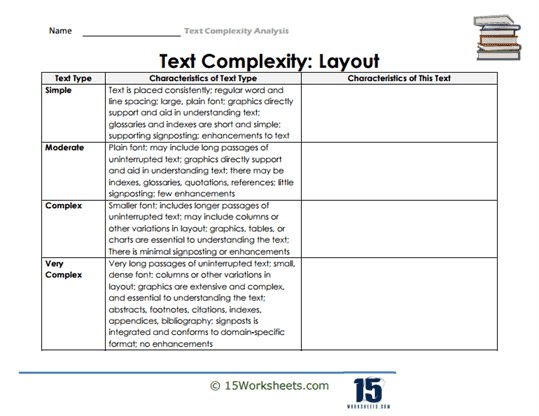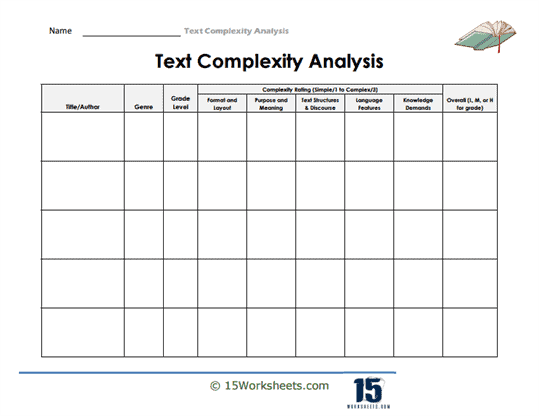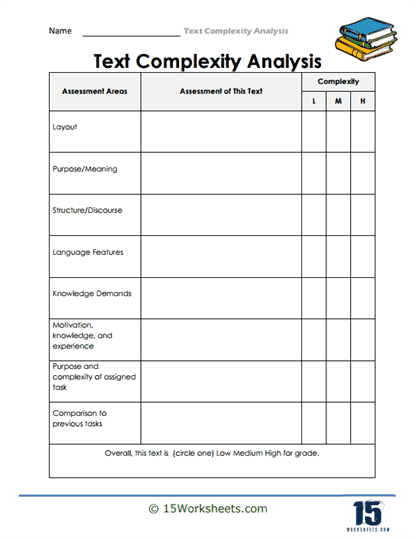Text Complexity Analysis Worksheets
All About These 15 Worksheets
Reading comprehension is a multifaceted skill that extends beyond simply decoding words; it encompasses the ability to engage with and understand texts of varying complexities.
The Text Complexity Analysis Worksheets Collection is a valuable resource for students, providing them with 15 worksheets designed to hone their skills in assessing text complexity.
These worksheets offer a deep dive into understanding the components that make up complex texts, ultimately empowering students to tackle a wide range of materials confidently. In this description, we will explore the importance of text complexity analysis and the numerous benefits it offers to students.
The Importance of Text Complexity Analysis
Text complexity analysis is a vital aspect of reading comprehension. It involves evaluating texts based on their linguistic, structural, and conceptual features. Here’s why text complexity analysis is crucial for students:
- Academic Preparedness: Texts in various academic subjects, from literature to science, vary in complexity. Students must be equipped to tackle texts appropriate to their grade level and beyond to excel in their studies.
- Critical Thinking: Analyzing text complexity encourages critical thinking. Students learn to assess the difficulty of texts, identify key elements, and determine how the text structure influences comprehension.
- Effective Reading Strategies: Understanding text complexity helps students select appropriate reading strategies. They can adjust their approach to match the complexity of the text, improving their overall comprehension.
- College and Career Readiness: In higher education and the professional world, students encounter complex texts regularly. Proficiency in text complexity analysis is essential for success in these settings.
- Informed Decision-Making: Beyond academics, text complexity analysis equips students to assess various types of information critically. They can make informed choices about what to read and engage with in an increasingly information-rich environment.
Determining Text Complexity
Text complexity refers to the level of challenge a given text presents to the reader. Understanding text complexity can help educators, students, and parents select appropriate materials for reading and learning.
You can determine how easy or difficult a book is to read with the help of the criteria. There is an equal weight given to each component in the model. Teachers can help and challenge students to read more complex texts as they prepare for college and careers using these quantitative and qualitative indicators of text complexity.
Grade K-12 is a critical time in a student’s education. They must learn to comprehend increasingly tricky literature and independently determine text complexity.
Text Complexity
An exact science does not exist for determining a text’s complexity. There is no single source of information that correctly summarizes the text. You need to examine the following elements to determine the complexity of the text:
Qualitative Measures
Various elements must be considered to determine the difficulty of a piece of writing. To gauge a book’s complexity, the Standards look at factors such as the author’s intent, the text’s structure, the conventions of the language, and its clarity.
Qualitative metrics is an important source of information in making decisions concerning the text’s complexity and how it should be used with students. Many elements contribute to a complex system defined by the Common Core State Standards. Literacy and informational texts each have their own set of rubrics that include descriptions for the text.
Language features: The complexity of the vocabulary, sentence structure, and language conventions used in the text.
Text structure: The organization and layout of the text, as well as the presence of features like headings, subheadings, and illustrations.
Levels of meaning: The presence of multiple layers of meaning, including themes, subtext, symbolism, and figurative language.
Knowledge demands: The amount of background knowledge required to understand the text, including cultural, historical, and disciplinary knowledge.
Quantitative Measures
The difficulty of a text can be measured quantitatively by criteria such as the length of sentences and phrases and the frequency with which terms in the text are unfamiliar (grade level equivalent, number, Lexile, etc.). The difficulty level of a text might change depending on which formulae or measures are utilized. Hence, applying various formulae to get an accurate reading is important.
These measures are quite helpful in establishing a text’s level of difficulty. However, they aren’t enough on their own. Lexile levels, or grade-band equivalents, are given by most publishers for their books. As you might expect from the higher number, a Lexile book is much more difficult to understand.
These are measurable factors that can be calculated through the use of readability formulas or tools. They include:
Word length and frequency: Longer and less frequently used words are generally more challenging for readers.
Sentence length and complexity: Longer sentences with more complex syntax can be more difficult to understand.
Lexile measures: A widely used metric for text complexity, Lexile scores estimate the reading level of a text based on word frequency and sentence length.
Reader’s Position
Evaluate the writer’s contributions to the material and their performance on specified tasks. Draw on your extensive knowledge of texts to make meaningful connections between the two.
These factors depend on the individual reader and the purpose of the reading. Some elements to consider include:
Reader’s motivation and interest: A reader’s engagement with a topic can affect their ability to comprehend a text.
Prior knowledge: A reader’s background knowledge can influence their understanding of a text.
Reading purpose: The reason for reading a text (e.g., for entertainment, to gather information, or to analyze) can impact the level of complexity a reader experiences.
Cognitive abilities: A reader’s cognitive skills, such as working memory and reasoning, can affect their ability to process and understand a text.
Empowering Students Through Text Complexity Analysis
The Text Complexity Analysis Worksheets Collection equips students with the essential skill of assessing text complexity, enabling them to engage with a wide range of materials effectively. By mastering the ability to analyze the linguistic, structural, and conceptual features of texts, students become more confident and proficient readers.
As students engage with worksheets that explore the components of text complexity, they develop the capacity to think critically, adapt their reading strategies, and tackle a diverse array of texts with ease. These skills are not only essential for academic success but also for informed decision-making and success in an information-rich world.
Empower your students to unlock the power of texts with confidence, becoming skilled readers and critical thinkers who can assess and engage with complex materials. Invest in their educational journey and their future with the Text Complexity Analysis Worksheets Collection.
Equip them with the skills to thrive in the realm of diverse and challenging texts, one worksheet at a time, and watch as your students become more discerning, adaptable, and analytically skilled readers and thinkers.

